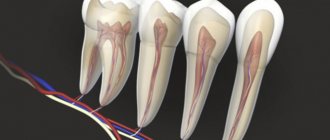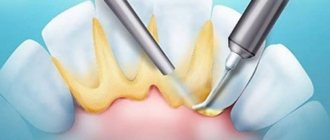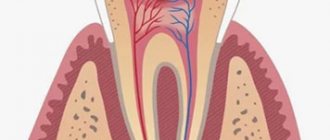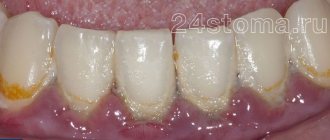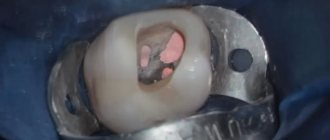- January 18, 2019
- Dentistry
- Elena Zhmakina
Intense toothache may indicate an inflammatory process affecting the nerve. Pulsation radiating to the temple or neck, increasing pain at night and in a lying position are just a few of the main symptoms that indicate that the dental nerve needs to be removed. A dentist can professionally carry out this procedure, but it is not always possible to immediately get to him at the first symptoms. And at such moments, when not a single painkiller alleviates the condition, a person asks the question: is it possible to kill the dental nerve at home?
Why remove nerve endings?
Under the crown of the tooth there are nerve endings. They spread through the canals and reach the tooth roots. Nerves provide unity between the dental system and the central nervous system. They have their own sensory function. Pain in a tooth is a signal that indicates that the soft layers under the crown have undergone destruction.
As a result of depulpation (this is the removal of a bundle of nerves in the tooth canal), the pain goes away. After this procedure, the nutrition of the tooth ends. Subsequently, you will just need to monitor the crown and visit the dentist regularly. If you do not do this, the tooth will turn black and decay.
It is possible to save a nerve if a person asked for help in time, and did not look for an answer to the question of how to properly kill a dental nerve, and did not try a lot of different remedies on himself. Even if partial damage to the pulp has occurred, there is still a chance to neutralize the area without removing the pulp.
If you regularly visit a specialist, you may never encounter such problems.
Symptoms of the lesion
The main symptom of damage to the nerve endings in the tooth is pain. The patient will not be able to accurately indicate the location of the pain, since it is vague and can radiate to the ear, temple or eye. The symptom tends to increase with any jaw movements (during talking or eating). A sick tooth reacts very sharply to cold, hot or salty foods.
We invite you to familiarize yourself with Zirconium crowns. Zirconium teeth and their advantages. RedWhite Clinic of Modern Dentistry. Dentistry Tver
Another common sign of pathology is swelling of the cheeks and mucous membranes of the mouth. The symptom occurs due to inflammation of the pulp and compression of the nerve endings of the tooth. The intensity of pain usually changes when a person assumes different body positions. The attacks reach their maximum intensity at the moment when a person goes to bed. This is due to the fact that blood circulation in the affected area increases.
Why do you need to remove the affected tooth nerves? Without treatment, the infection can spread to the trigeminal nerve, resulting in pulpitis complicated by trigeminal neuralgia. The condition's symptoms are similar to a cold of the nerves.
It is easy to distinguish neuralgia from pulpitis: the pain is unilateral and manifests itself as involuntary muscle twitching. In more complex cases, a nervous tic may occur. The consequence is manifested by impaired facial expressions, one-sided distortion of the face
When is nerve removal indicated?
If a person experiences severe pain that intensifies at night, and there is pulsation, then in this case depulpation cannot be avoided. But there are situations when there is no pain, but you still have to remove the nerve. Before answering the question of how to kill a dental nerve, let’s look at the reasons that lead to such a procedure:
- Pulpitis. These are the consequences of previously untreated caries, which gradually destroys the tooth and reaches the pulp, causing an inflammatory process. As a result, pain appears that requires radical measures: removal of the nerve and filling of the canals.
- Cyst or granuloma. They also contribute to the disruption of the sensitive area of the tooth and are removed only through the canals.
- Tooth injury. Any damage results in damage to the tooth enamel, which affects the nerve. If the frontal area is injured, then complete depulpation is performed. If the problem affects the back teeth, it is possible to partially remove the nerve.
- Prosthetics. If a person needs to get a bridge or crown, then the nerve must first be killed. This way you can reduce the risk of developing inflammation under the crown.
A specialist knows how to kill the dental nerve, so at the first symptoms it is better to seek qualified help.
Manifestations and causes of nerve inflammation
You can determine that the nerve of a tooth is inflamed by several signs:
- Increased pain when turning or tilting the head. The pain spreads to several teeth at once; it is difficult to determine which one hurts.
- Constant discomfort in the neck and temple area.
- An inflamed nerve quickly reacts to any irritant: hot and cold water, the same reaction can be expected from sweets.
Only a dentist can determine exactly what the reason is and choose the best medicine that kills the dental nerve.
How to properly prepare for house removal?
Before answering the question of how to remove a dental nerve at home, you need to prepare for this procedure:
- Clean the canals well to prevent suppuration. This can be done with a toothbrush and toothpaste, removing plaque and all food debris.
- Take a needle, disinfect it in alcohol and clean the hollow in the tooth with the non-sharp side.
- Use chamomile decoction to rinse your mouth or apply a special dental elixir.
Only after such manipulations can you begin to remove the nerve.
Is it possible to kill a dental nerve at home? Yes, you can, but this does not mean that the work is over and you can live without worrying about anything. After the procedure, it is necessary to remove the nerve fibers, otherwise infection may begin.
How to quickly kill a dental nerve: simple methods
There are a lot of available remedies to kill the nerve, always at hand at home. Here are some effective methods that will help alleviate the condition and wait until you visit the dentist:
- Salt. This is the simplest remedy to help get rid of toothache. In 1 tbsp. warm water should be diluted with 1 tsp. salt and rinse your mouth with this saline solution. As a result, acute pain can be relieved.
- Salt and garlic. Pass a clove of garlic through a press and rub with salt. Place the resulting pulp on the sore tooth. This remedy has an analgesic and antimicrobial effect. If swelling of the gums is observed, you can additionally rinse your mouth with a decoction of garlic.
- Propolis tincture. You can purchase it at any pharmacy or prepare it yourself. You will need to take 30 g of raw material and pour a glass of alcohol, leave in a dark place for 10 days. If you soak a cotton swab in the tincture and place it on the tooth, the pain will go away.
- 3% hydrogen peroxide. It is diluted with water in a ratio of 2:1, moistened with a cotton swab and placed on the sore tooth.
- Onion peel. Pour a small handful of husks into 2 tbsp. boiling water, let it simmer over low heat. Strain the broth, leave for 2 hours, and then use it to rinse the mouth.
- Herbal infusions are good for soothing pain. Chamomile, mint, sage, thyme and oak bark are suitable for this. You only need to rinse with warm broth.
These methods will not harm human health, but they are not always effective.
Cardinal methods
If rinsing and lotions do not help, then how can you kill the dental nerve at home? There are several drastic methods, but they can cause serious harm, so they are recommended to be used only in difficult cases and with extreme caution. Here are a few remedies:
- Vinegar essence. You need to moisten a cotton swab in it and place it carefully in the hollow of the tooth. But initially you need to thoroughly disinfect your hands to prevent infection. The procedure must be carried out carefully so as not to burn the gums.
- Alcohol. If rinsing with alcohol tinctures does not give any results, then you can moisten a cotton swab in medical alcohol and place it in the hollow of the tooth.
- Zinc. Not everyone has this substance in their home, but you can extract it yourself from printing ink. You need to take a sheet of newspaper with a large black design, crumple it up and set it on fire. Use a cotton swab moistened with human saliva to collect the ashes and place them in the tooth. This procedure is painful, so it is recommended to take a painkiller 20 minutes before the procedure.
Whatever method is used at home, you need to remember that this is a temporary measure; a visit to the dentist should still be necessary.
Medications
You can kill the nerve in a tooth at home using pharmaceutical medications. To do this, you can use special dental pastes that do not contain arsenic. These include “Devit-P” and “Devit-S”. You need to brush your teeth well, clean the canals from food debris and put a pea of paste in the hollow, fix it with dental glue recommended for fixing dentures. All this can be easily purchased at any pharmacy, and it is safe for health.
When choosing pharmaceutical products that kill the dental nerve, you need to remember that some of them may contain arsenic, which can be harmful to health if used incorrectly. It is better to immediately check the composition of the drug with a pharmacist or read the instructions for it.
Further treatment
It should be remembered that all home recipes aimed at eliminating toothache associated with nerve damage are temporary measures. They certainly alleviate the patient’s condition, but cannot cure the disease that provoked this phenomenon. That is why people suffering from severe pain due to nerve irritation need to consult a dentist the very next day after the onset of such a symptom. The doctor will determine the cause of the disease and prescribe qualified treatment. In some cases, it may even involve removing the nerve. Self-medication can lead to complications.
Read also: Cold gums
In general, relieving pain caused by an irritated nerve at home is not that difficult. To do this, it is enough to use a folk recipe or a pharmaceutical remedy, and you can get rid of the unpleasant sensations for the next few hours.
What should you not do if you have severe tooth pain?
We have already described several ways to kill the dental nerve at home, but there are procedures that should never be done, otherwise the consequences will be disastrous:
- Warming up. Hot compresses will only worsen the symptoms.
- Rest in a lying position. In the lying position, blood circulation is activated, and blood flows faster to the teeth. As a result, the pressure increases and the pain syndrome intensifies.
- Using a needle. Do not penetrate into the hollow of the tooth with a sharp needle, as this can damage soft tissues and cause bleeding.
All these methods lead to serious and irreversible consequences, which will then take a long time to eliminate in the dental office.
What actions at home can aggravate the problem?
If there is toothache and an exposed nerve, not everyone tries to see a doctor right away. Some resort to all sorts of pain relief methods. But here you need to know when to stop and not cause even more harm to your health. Let's consider what actions can have negative consequences:
- warming up the inflamed area: this will further increase the pain and cause inflammation to progress due to the rush of blood, as well as the spread of bacteria along with blood flow to nearby tissues,
- rinsing with hot solutions and decoctions: hot water can injure the mucous membranes and lead to exactly the same effect as warming procedures,
- applying a crushed aspirin tablet to the tooth: this drug, when applied externally, can cause severe burns and irritation of the mucous membrane,
- lotions with alcohol tinctures: similar to aspirin, they will dry out and damage the mucous membrane,
- being in a horizontal position: when the head is at the same level with the body, blood flow and pressure increase, due to which the pain only becomes stronger. To make the situation easier, on the contrary, you need to place your head higher than your body. You can use a high pillow for this.
How to remove a nerve at home?
This method of treatment is considered prohibited, because a person can harm his health. Dentists recommend resorting to it only if other methods have not helped, you can’t get to a specialist, and the pain does not calm down.
Pulp removal at home must be carried out carefully, after first assessing the patient’s condition and determining whether there is periodontitis, an infection. If the gums are inflamed and the pain spreads to several teeth at once, then the procedure is dangerous. It's better to see a doctor.
Before removal, clean the cavity well, put in it homemade medicine or purchased at a pharmacy, which will kill the nerve.
How long does it take to die
Killing the nerve is called a devitalization procedure. This relieves periodic pain when eating cold, hot or sweet foods. The nerve dies from a day to several days or even months - it all depends on the method used for this. If a special remedy is used, then you won’t have to wait long - the well-known arsenic neutralizes nerve endings within 24 hours or even less.
If the decision was made not to touch the entire destroyed tooth, then you will have to endure periodic unbearable pain for several months - killing occurs due to developing dangerous bacteria. It is prohibited to resort to such a method, because it is fraught with the formation of a cyst due to the discarded “waste” into the gums and pulp.
What to do when the nerve is removed?
After depulpation at home has been carried out, you need to thoroughly clean your mouth with running water and go to the dentist. If the dead pulp is not removed in time, it can lead to osteonecrosis of the jaw.
After the procedure, it is recommended to rinse your mouth with medicinal herbs, which help relieve inflammation and prevent infection. Chamomile is suitable for these purposes. But you shouldn’t delay going to the dentist; this should be done no later than two weeks after the nerve is removed.
How do dentists remove a nerve?
Just 20 years ago, it was not possible to perform the nerve removal procedure in a doctor’s office in one go. But today, thanks to effective anesthetic agents, everything is possible. Initially, the doctor will numb the tooth, then clean the canal to get to the pulp. He will remove it and install a temporary filling. Only at the next visit, which may be scheduled in a few days, will the doctor be able to place a permanent filling, making sure that the removal of the nerve endings was completed correctly and without complications.
In addition to removing the pulp, the doctor may recommend partially removing the nerve, but he can make such a decision if the patient is a teenager or a child; in adult patients, the nerve is completely removed.
There is nothing difficult for a specialist in this procedure; immediately after the injection the patient feels relief, and after removal of the nerves the pain does not return. To prevent this condition, it is better to seek help immediately after discomfort appears in the tooth or a hole is discovered.
Depulpation
After the nerve has been killed, work is carried out to remove it, which consists of several stages:
- Examination using x-ray equipment.
- Providing anesthesia. Most often, local anesthesia is used for this. Modern drugs allow you to quickly and permanently freeze a tooth without causing harm to the patient’s health. If desired or if there are certain indications, general anesthesia can be used.
- Preparation of the work area, which includes applying a rubber dam and installing a saliva ejector.
- Removing the temporary filling, cleaning the cavity and expanding the canals. At the same stage, the formation of cavity walls and aseptic treatment are carried out.
- Nerve removal. This operation is carried out using a special tool - a pulp extractor. This is a disposable shortened flat knitting needle with fine teeth on the end sides.
The vascular bundle is extracted by introducing a pulp extractor into the expanded canal and rotating it around its axis by 180°C. To completely remove one nerve, several extractors must be used.Also, to remove the nerve, another, more gentle technique can be used using universal dental files, which carefully cut the pulp without injuring adjacent tissues.
- Treatment of cavities and canals followed by filling with permanent composite.
Complications
Finding the answer to the question of how to kill the dental nerve is only half the battle; you also need to think about what complications a person can expect. He may encounter the following problems:
- Allergy to the drug used to kill the nerve. An allergic reaction can cause swelling of the larynx and stop breathing.
- Damage to healthy tissues located in the immediate vicinity. Often, an inexperienced person who decides to remove the dental nerve on his own during the procedure affects healthy tissue, as a result of which the dentist has to restore not only the teeth, but the entire oral cavity.
- Burns, taste disorder. If you do not follow the dosage of the drug that is used to kill the dental nerve, this can lead to a burn of the mucous membrane. As a result, you will no longer be able to taste food normally. Problems with swallowing will also begin to appear.
- Tooth infection. Often, when killing a nerve at home, people get an infection. Bacteria enter the tooth cavity through poorly disinfected instruments or dirty hands.
If possible, it is better to seek help from a dentist. The consequences are often much more painful than removing the nerve.
Arsenic pastes
Pastes made from arsenic are successfully used by dentists to devitalize the dental nerve. They act quickly but aggressively, the process takes 1-2 days.
The composition of arsenic pastes includes:
- arsenous anhydrite – has a necrotic effect;
- local anesthetic - allows you to quickly relieve pain (for example, Dicaine);
- strong antiseptic – suppresses the vital activity of microflora in the tooth cavity, prevents its spread to nearby tissues, disinfects the pulp (camphor, thymol);
- astringent components - help to increase the duration of the paste, for example, if the patient’s visit cannot take place in the coming days (tannin).
Everyone knows about the toxic properties of arsenic. So why do dentists continue to use it? Most often, the reason for using arsenic pastes is that the patient is allergic to other types of anesthetic. In addition, the modern formula of the substance and improved methods of use make it possible to minimize the negative effect.
We invite you to familiarize yourself with the most effective medications for herpes on the lips - list of drugs
There are certain rules for using arsenic pastes. They are applied to the exposed pulp. It is possible to apply it to an unopened pulp, but with this option there is a high probability of swelling and increased pressure in the cavity. To avoid the negative effect of arsenic on healthy tissue due to the “leakage” of components through the cavity, try to leave a distance of at least 2 mm from the top of the paste to the edge of the cavity. A cotton roll soaked in anesthetic is placed on top of the paste. A water-based dentin bandage is applied on top.
The period for applying arsenic paste is usually one day for incisors and canines, and two days for molars. The maximum duration is specified by the manufacturer. Examples of arsenic pastes used by dentists are Devit-Ars, Kaustinerv Rapid, Pulparsen, Septodont.
